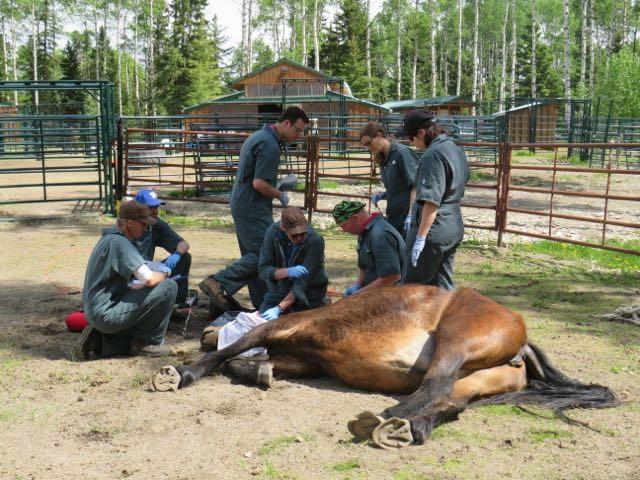
A "bachelor group" of wild stallions crashed through a landowner's fence and made themselves at home.
Bob Henderson
June 24, 2022

When a "bachelor group" of wild horses started breaking down fences and causing trouble for a landowner in central Alberta, UCalgary Faculty of Veterinary Medicine (UCVM) veterinarians, animal health technicians, and students worked with a local non-profit society to help facilitate a solution.
Dr. Bruce Stover, DVM, an instructor at UCVM, learned from the Wild Horses of Alberta Society (WHOAS) about the disorderly young stallions. Stover has been working with the non-profit advocacy group for nearly a decade.
“The boys, I always call them, they're kind of like the 7-Eleven gang, a group of teenagers that are up to no good. Around the age of two, young male horses become sexually mature, and the stallion of the herd boots them out.
“These lone boys form bachelor groups. And when they come across domestic mares in heat, they cause trouble.” When this particular bachelor group crashed through fences and made themselves at home on private land, the owner had to take further action to protect her mares, and WHOAS was contacted to help.

A "bachelor group" of wild stallions crashed through a landowner's fence and made themselves at home.
Bob Henderson
“One of the things that WHOAS does is they intervene when the government asks them to,” Stover says. “With the appropriate government permits, they’ll go out, they'll fix fences, corral the horses and take them back to their rescue facility.
"In this case, they asked us to help out by gelding (castrating) and freeze branding the horses so they could be adopted to new homes and start new chapters as domestic horses.”
But gelding a wild horse requires a much different approach than it does for domestic horses.
“You can't just walk up to them and do a physical exam as you would with a domestic horse. And you can’t access the jugular vein to anesthetize them because they’re still wild and hard to handle.”
On top of that, drugs of a higher concentration and with a stronger affinity for the drug receptors are needed because these same receptors are involved with the "fight or flight" stress response — a response that is more evolved in wild horses and can easily override attempts at successful sedation.

UCVM veterinarians, animal health technicians, and students split into teams, to benefit student learning.
Bob Henderson
When Stover first started working with the wild horses, he had some trouble coming up with an effective sedation and anaesthesia strategy. He enlisted the help of UCVM’s Dr. Nigel Caulkett, DVM, a board-certified expert in veterinary anaesthesia, to develop a safe and effective process and pharmaceutical cocktail. They published a case report on the protocol in the Canadian Veterinary Journal.
“Part of the protocol that we've been developing, we use very, very concentrated drugs and we’re able to inject them just in the muscles of the neck. It’s a lot easier, and safer, to hit the big target of the neck than try and fuss around to get a jugular vein on a wild horse.”
Once sedated in the specialized handling facilities at WHOAS, the horses are led to a pen for surgery prep. “They're not anaesthetized at this point, just heavily sedated. And once they're sedated, with an increased margin of safety, we can walk up to them and access the jugular vein and anaesthetize them for surgery.”

Throughout the day, the teams switched up duties, so students got experiential learning in all areas.
Bob Henderson
Stover and a group of UCVM veterinarians, animal health technicians, and students split into teams, to benefit student learning. “We had a team on anaesthesia, a team on surgery, and then a team that kind of handled everything else.”
That included freeze branding, removal of wolf teeth, and injecting antibiotics and medication for post-operative pain control. Throughout the day, the teams switched up duties, so students got experiential learning in all areas.
You might say it takes a village to geld a group of wild horses, Stover says with a laugh. After a full day of working with veterinarians, technicians, and volunteers, UCVM students left knowing a lot more about wild horse behaviour as well as honing their clinical skills and building community connections.
And the five wild horses? WHOAS has worked to "gentle" the animals, and each has been adopted to a new home.